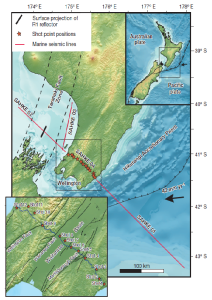New Zealand researchers have developed the clearest picture yet of what happens at the base of tectonic plates and how they move across Earth’s surface in a study published in Nature today.

For the first time, an international team of scientists based out of Wellington, has been able to see 100 kilometres under the earth’s surface and underneath the Pacific and Australian tectonic plates.
The scientists’ findings have uncovered what appears to be a thin layer of soft or molten rock at the base of the Pacific plate — some 100 km underground — which allows the plates to slide and move.
“The idea that Earth’s surface consists of a mosaic of moving plates is a well-established scientific paradigm, but it had never been clear about what actually moves the plates around,” says Victoria University’s Professor Tim Stern in a media release.
To find out, Prof. Stern, GNS Science’s Dr. Stuart Henrys and their team took a cross-section of the lower North Island in 2011, from Kapiti to the opposite Wairarapa coast. With 60 volunteers, they planted 12 dynamite charges and buried almost 900 seismographs to record the echoing waves along this route.
Over two nights, these explosives were set off one by one, in blasts heard 10km away – detonated in the early hours of the morning while people were asleep.
“These instruments record very, very tiny ground motion. A car or truck going by would wipe out a seismograph record nearly a kilometre away,” Prof. Stern explained to the Dominion Post.
“By generating our own seismic waves using higher frequency dynamite shots we were able to see how they became modified as they passed through different layers in the earth. This, along with some new techniques in seismic reflection processing, allowed us to obtain the most detailed image yet of an oceanic tectonic plate.”
The research will help scientists gain more knowledge about how Earth formed and evolved.
The study has been covered in New Zealand and global media. Examples include:
New Zealand Herald: Kiwi scientists reveal what happens beneath Earth’s tectonic plates
One News: What lies beneath? Kiwi scientists make tectonic plate breakthrough
3 News: Dynamite sheds light on NZ tectonic plates | NZNews | 3 News
Dominion Post: Big bang opens tectonic plate to Vic researchers
Herald Sun: Dynamite used for NZ tectonic plates study | Herald Sun
Smithsonian: Scientists Have Imaged the Base of a Tectonic Plate | Science | Smithsonian
Science News: Geologists discover tectonic plate’s slippery underbelly | Science News
Live Science: Hidden Molten Channel Beneath Earth Discovered with a Blast